City of Santa Monica - Adaptive Reuse Ordinance

In the fall of 2024, the City of Santa Monica adopted an Adaptive Reuse Ordinance to encourage housing production and incentivize the reuse of underutilized commercial buildings and sites. Omgivning has extensive experience crafting adaptive reuse policies for cities, and they worked with the City of Santa Monica to fine-tune this innovative policy and test it out with five redevelopment schemes.
While Santa Monica has large office buildings that could be converted or partially converted, there are many smaller commercial buildings that are underutilized as well. These buildings are often at risk of demolition, potentially being replaced with oversized developments that could drastically alter the city’s character and scale. Santa Monica has always been forward-thinking in its approach to policy and redevelopment and recognizes that discouraging demolition and promoting reuse are essential components for creating a sustainable and resilient city. In addition, this approach also helps to maintain the charm of the city while introducing more housing and helping to make reuse economically viable.
Santa Monica’s planning department has crafted a smart and thoughtful ordinance that offers financial incentives to property owners and developers to increase density and revenue potential, while also focusing on sustainability and preserving the character of the city’s streetscapes.
Feasibility Assessments Steps for Adaptive Reuse
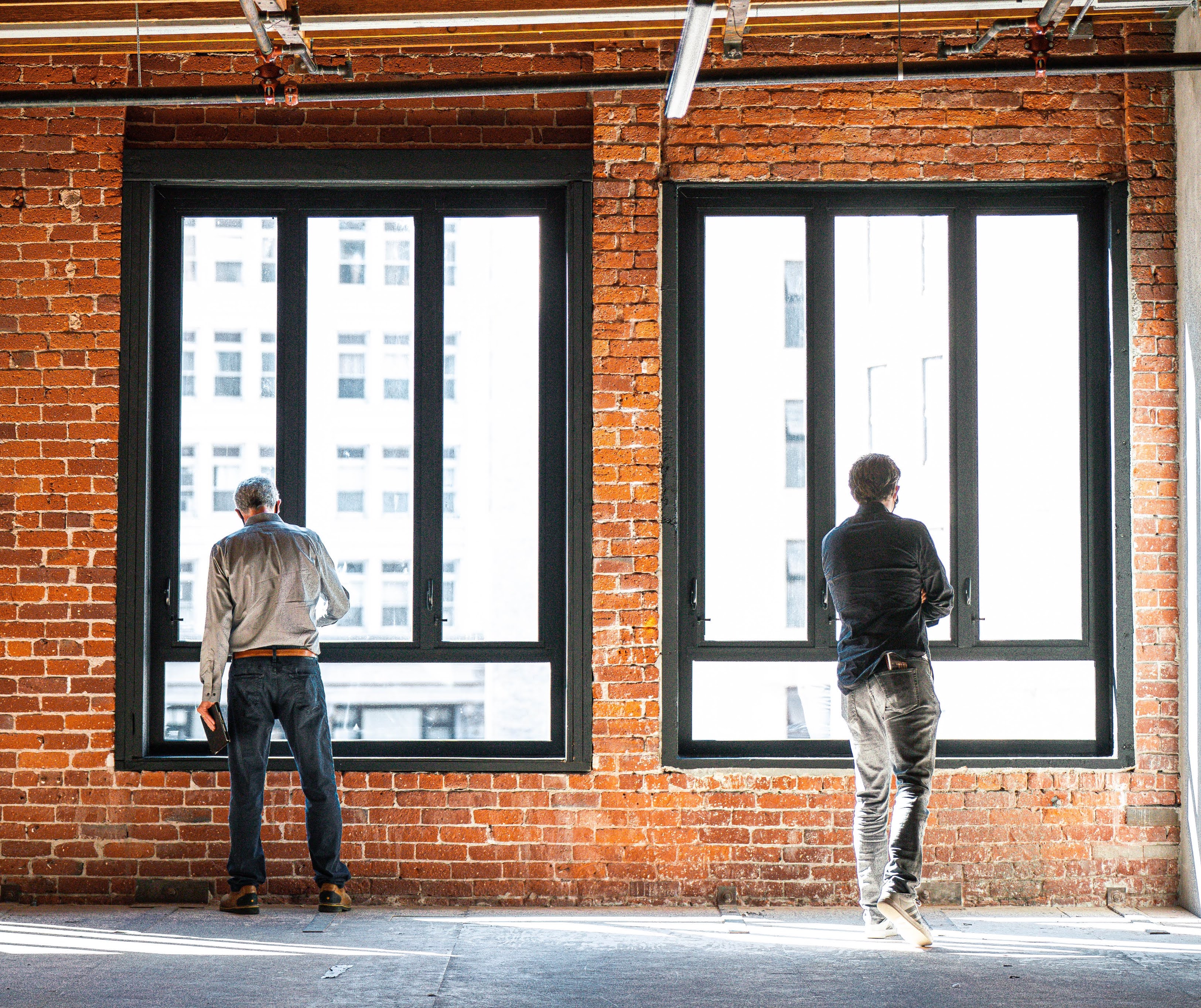
STEP ONE: Quick Start Feasibility
Is The Project Worth Pursuing?
Quick Start Feasibility is the first step in exploring the potential of your building for adaptive reuse. With a focus on a low cost study, efficiency, and actionable insights, this service is the first step for clients who need a swift yet reliable evaluation of whether a project is worth moving forward with.
Process
Site Visit
-- Brief site visit walkthrough with architect, structural engineer, and general contractor to assess the building’s current condition and potential for reuse.
High-Level Code and Zoning Review
-- High level analysis of critical codes and zoning regulations to identify potential barriers or opportunities for your project’s feasibility.
Existing Documentation Review
-- Review any existing building documentation provided.
Structural Input
-- High level analysis of seismic upgrade triggers and anticipated upgrades with ballpark cost based on comparative projects.
Deliverables
-- Plan Diagram (program diagrams showing leasable sf, unit counts, etc.)
-- Summary of initial code review, adaptive reuse incentives, and list of challenges and opportunities
-- Rough Order of Magnitude (ROM) budget
Our team, with decades of adaptive reuse experience, can quickly assess the key factors needed for our clients to decide if a project is feasible. If so, this study lays the foundation for the next step of deeper exploration onto the Viability Blueprint.
Los Angeles Conservancy Panel: Adaptive Reuse and Preservations Broader Role in Housing
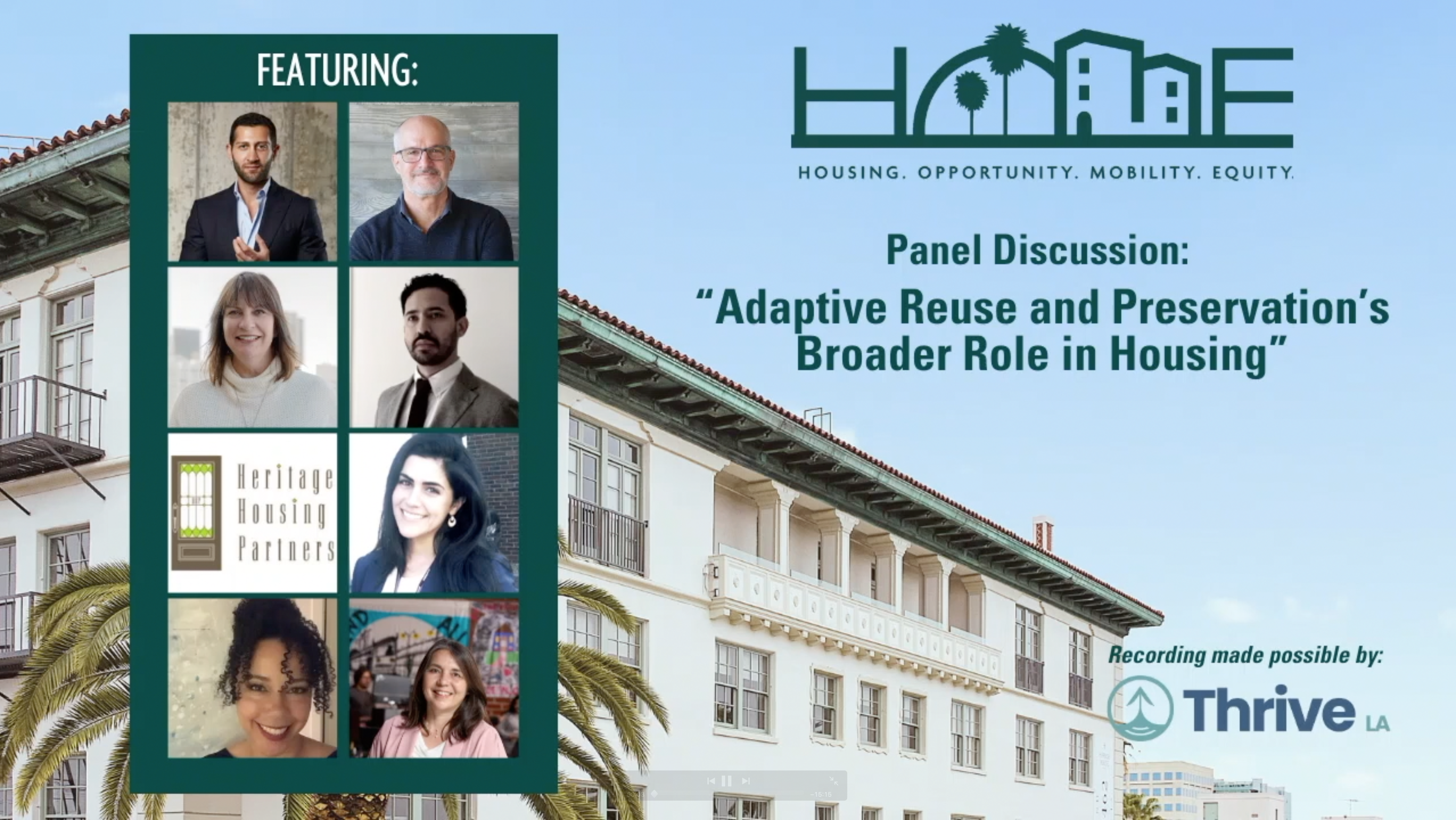
Los Angeles Conservancy H.O.M.E. - Housing. Opportunity. Mobility. Equity Panel Discussion in 2024
Karin Liljegren, FAIA, joined the The L.A. Conservancy for a panel discussion on housing and their new campaign, HOME, and the important role preservation plays in maintaining affordability, creating new housing, and offering solutions to the housing crisis in Los Angeles.
See what Karin has to say about why Adaptive Reuse worked in downtown Los Angeles.
Advocacy by Omgivning

As a practicing architecture and interior design firm, we hold a tremendous responsibility to our clients and, ultimately, to our communities to design solutions that positively impact our world. Since our founding in 2009, we have been at the forefront of advocacy and policy-making specifically targeting the reuse of buildings.
As early as 1999, before founding Omgivning, Karin Liljegren FAIA was the lead architect for 12 of LA’s first projects under the new Adaptive Reuse Ordinance. This ordinance catalyzed the return of historic downtown as a livable, walkable neighborhood, and launched our masterful understanding of the nuances and challenges of adaptive reuse. As one of the few with boots-on-the-ground experience, Karin started her advocacy efforts in 2001 and has carried them into the culture and core of Omgivning.

Here at Omgivning, we believe in being a catalyst for positive change. Our facility with the language of policy and development upends the idea that architecture is subservient to remote decisions by non-architects. By placing ourselves at the heart of the reform process, we are able to resolve complex technical, design, and economic challenges while uniting multiple constituencies. Our advocacy efforts demonstrate our commitment to urban revitalization by uniting the many interests of legislators, developers, planners, residents, and fellow architects.
Our design work and advocacy efforts are mutually reinforcing, and allow us to compound our impact on a community’s growth while adding deeper value to the solutions we provide. We operate at the broadest possible scale of policy while moving inward to affect a neighborhood’s blocks, buildings, and finally, the elements affecting a space’s individual users. This macro-to-micro approach ensures that every Omgivning project contributes to the vibrancy and resilience of the communities it serves.
The following is a list of efforts Omgivning has taken to make Adaptive Reuse projects faster, easier, and more affordable.
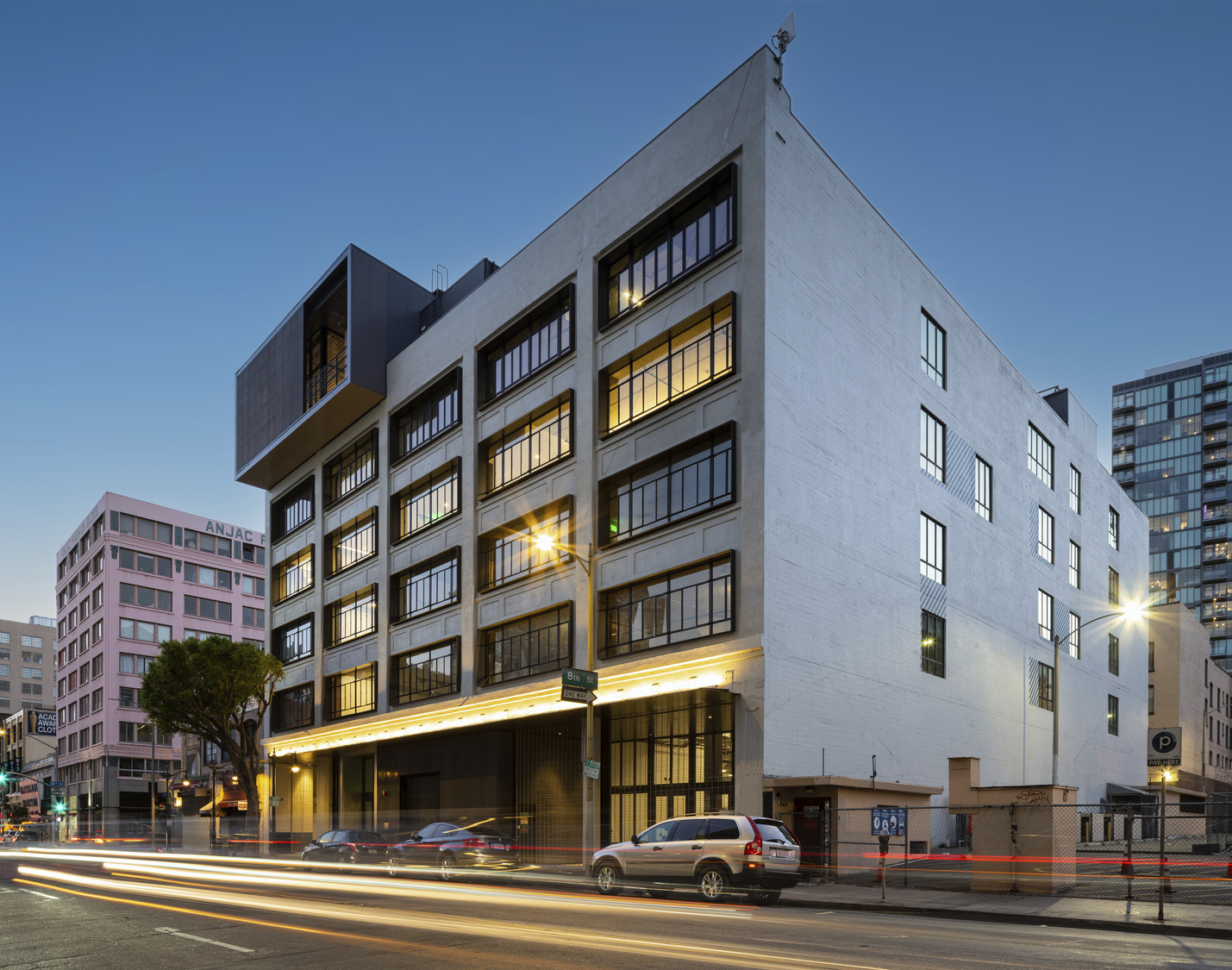
Advocacy - AB 529 - State of California Building Code Amendments: Adaptive Reuse Alternative Building Standards
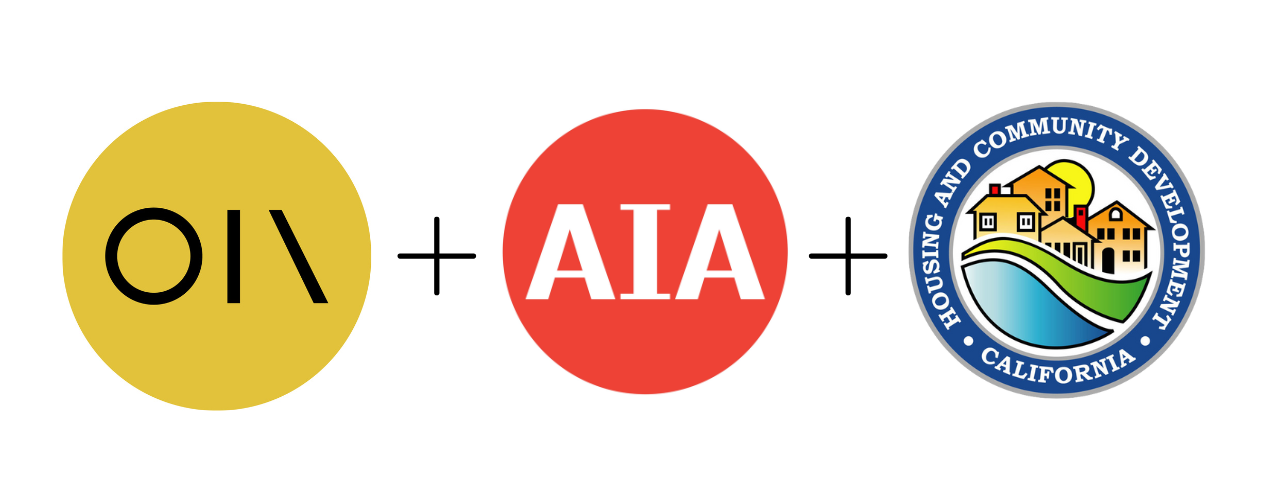
Agency / Organization:
AIA California / California Department of Housing and Community Development (HCD)
Status:
In Progress
Intent:
The Planning and Zoning Law requires each county and city to adopt a comprehensive, long-term general plan for the physical development of the county or city and specified land outside its boundaries, that includes, among other specified mandatory elements, a housing element. That law requires the Department of Housing and Community Development to determine whether the housing element is in substantial compliance with specified provisions of that law.
CA State Bill AB 529 would add the facilitation of the conversion or redevelopment of commercial properties into housing, including the adoption of adaptive reuse, ordinances or other mechanisms that reduce barriers to these conversions.
This bill required the Department of Housing and Community Development to convene a working group of which Omgivning was a significant participant under the leadership of AIA California. HCD requested that our group identify challenges to, and opportunities that help support, the creation and promotion of adaptive reuse residential projects, as specified, including identifying and recommending amendments to state building standards.
The bill requires the Department of Housing and Community Development to report its findings to the Legislature no later than December 31, 2025. The bill would require if the report identifies and recommends amendments to building standards, that the Department of Housing and Community Development and the other state agencies in the working group research, develop, and consider proposing adaptive reuse building standards for adoption by the California Building Standards Commission, as specified.
Advocacy - City of LA Building Code Amendments: Adaptive Reuse Alternative Building Standards
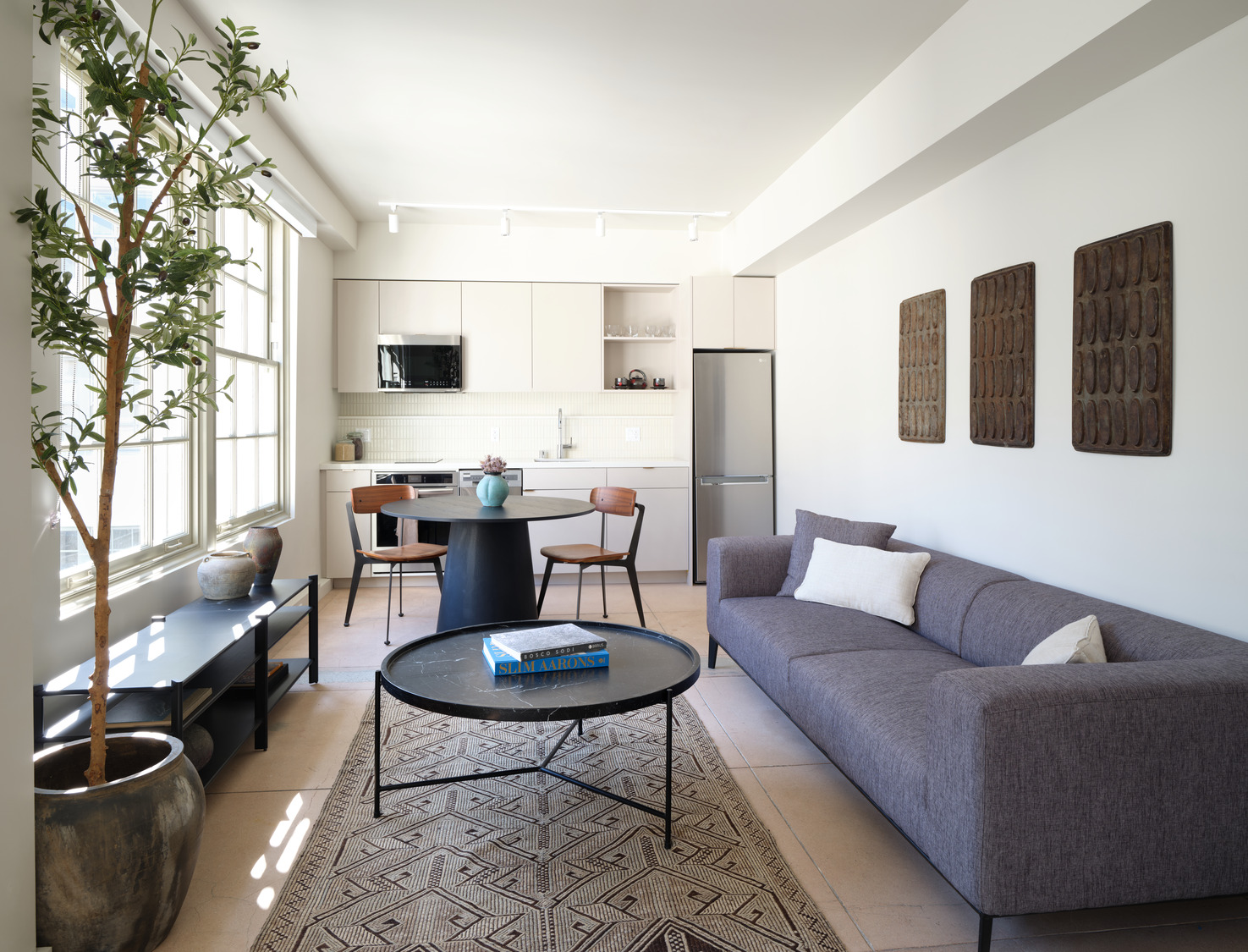
Agency / Organization:
Los Angeles Department of Building and Safety (LADBS) / Los Angeles Fire Department (LAFD)
Status:
In Progress - LADBS/LAFD working on alternative building standards Q3/Q4 2024. Currently on hold.
Intent:
The City of Los Angeles is rewriting their alternative building standards for the adaptive reuse of underutilized buildings to convert to residential use. When converting a building from an existing use to a new use, building codes require this change of use to bring the building up to current code. Bringing an existing building into compliance with current code can be impractical, and in most cases not viable, due to existing conditions and the high cost of upgrading buildings to a new use. The purpose is to make the adaptive reuse of our underutilized existing buildings more viable for conversion. The alternative codes will help reduce costs of conversions, as well as provide more certainty for Developers and Architects as to what will be required from LADBS (Los Angeles Department of Building and Safety) and LAFD (Los Angeles Fire Department). Without these alternative codes, each building would have to request modifications to the code that are reviewed on a case-by-case basis for approval which can often take 6-12 months. These new codes would help to reduce the amount of these case-by-case approvals, shave off significant plan check time and provide more certainty on what the City will allow. It is difficult for Developers to get funding or to keep their projects on track if there are significant unknowns that have big cost impacts on projects.
The City of LA would replace the relatively defunct LABC Chapter 85 that provided guidelines and clarity for what alternative standards would be allowed for the adaptive reuse of buildings. Chapter 85 was originally written to assist the new Adaptive Reuse Ordinance that came out in 1999. Both the ordinance and the building code were written particularly with one building type in mind - the 1920s historic high rises that existed in LA’s historic core. This new Chapter 85B is meant to update the old code, as well as to go hand in hand with LA’s new Adaptive Reuse Ordinance coming online in 2025 that will be updated and also expanded to be Citywide. This new ordinance will open up the planning/zoning incentives to the entire city, and also to a much broader range of building types including more recent buildings that may have reasonably compliant fire life safety and other systems.
Omgivning is one of 3 small private sector firms that has been workshopping the alternative codes with LADBS and LAFD. Our boots-on-the-ground experience, as well as our involvement with the Planning Department’s Adaptive Reuse Ordinance, have been critical to having a holistic understanding of the impact of various code requirements and being able to propose alternatives to appease all parties. In particular, it is difficult for city staff to understand the impact of their policies on the many different types of buildings or existing conditions. It is important to marry the intent of the planning/zoning policy which was to give Developers an incentive for adaptive reuse, such as allowing an addition on the roof. With alternative building codes, we must also take into consideration a roof addition without triggering significant additional requirements which might make that small addition infeasible and could potentially make the entire project infeasible.
Advocacy - City of Los Angeles - Adaptive Reuse Ordinance Downtown Los Angeles Community Plan Update - (DTLA 2040) and Citywide Adaptive Reuse Ordinance
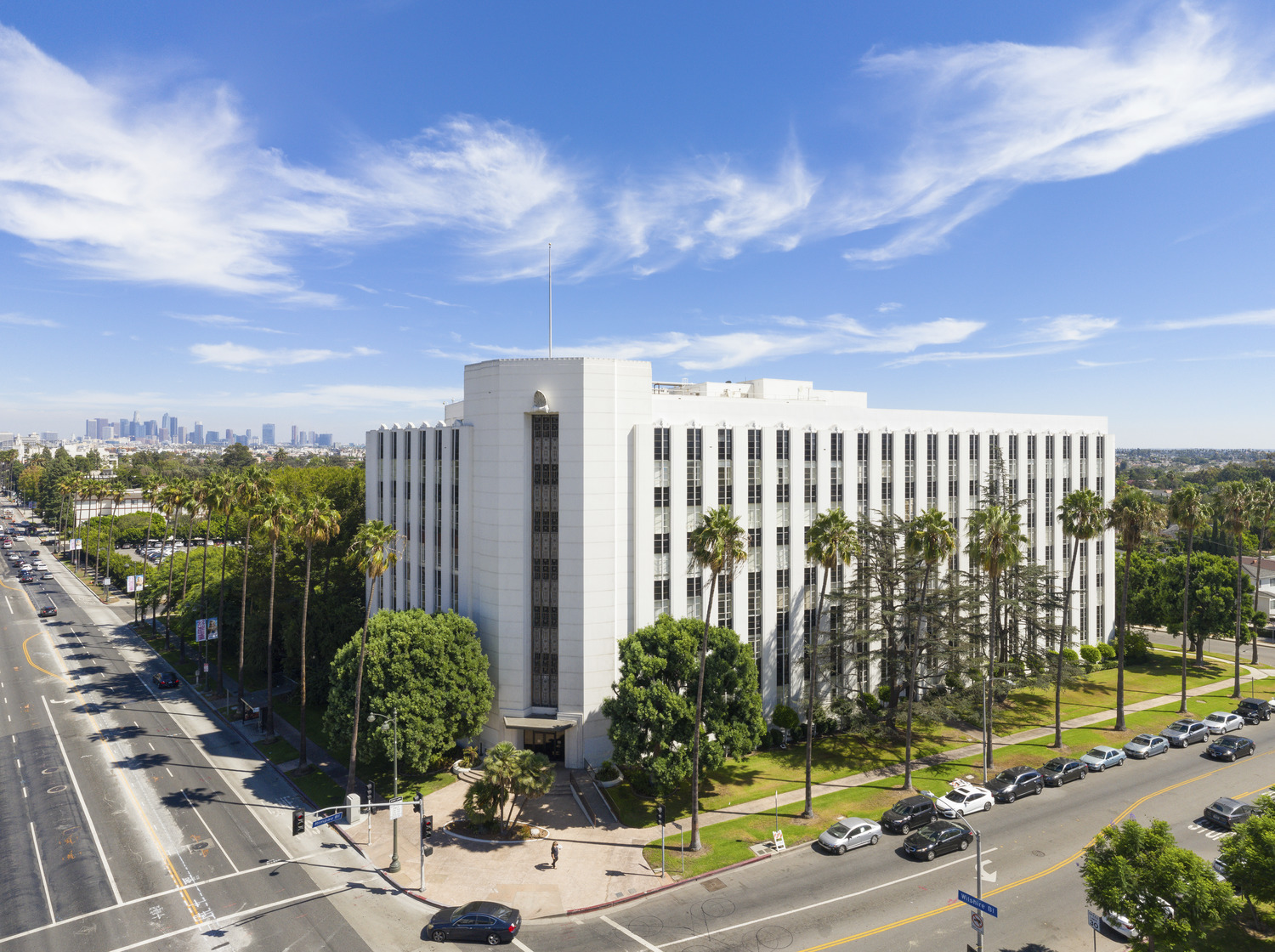
Agency / Organization:
City of Los Angeles, Planning Department
Status:
Complete
Intent:
Los Angeles’ original adaptive reuse ordinance, implemented in 1999 was highly successful creating 12,000 dwelling units, mostly in the first 10 years. Omgivning’s founder, Karin Liljegren led the first batch of these, converting 12 high rises to housing while employed at KFA. As Los Angeles began to rewrite their municipal code, they decided to start with Downtown and as a part of the new code, they would rewrite the Adaptive Reuse Ordinance. In addition the Regional Needs Housing Allocation (RHNA) provided encouragement to find new housing policy and the City of LA decided to craft a new ordinance that would span the entirety of the City of Los Angeles.
Omgivning worked with Los Angeles City Planning, AIA, Central City Association (CCA) and Los Angeles Office of Historic Resources on how to update and expand the current Adaptive Reuse Ordinance to be citywide. Omgivning applied the Planning Department’s Adaptive Reuse incentives to many case study buildings to understand the impacts of the code and if the incentives were adequate or needed to be enhanced. They also provided additional recommendations, created comparison data to the current Adaptive Reuse Ordinance code, and disseminated the information to leading advocacy groups, building owners and brokers.
Here's the current draft, set to be implemented in 2025: https://planning.lacity.gov/odocument/6725f347-7fdb-42fa-aa6e-44c37f8fa999/Fact_Sheet_-_Adaptive_Reuse_Ordinance.pdf
Advocacy - City of Santa Monica - Adaptive Reuse Ordinance
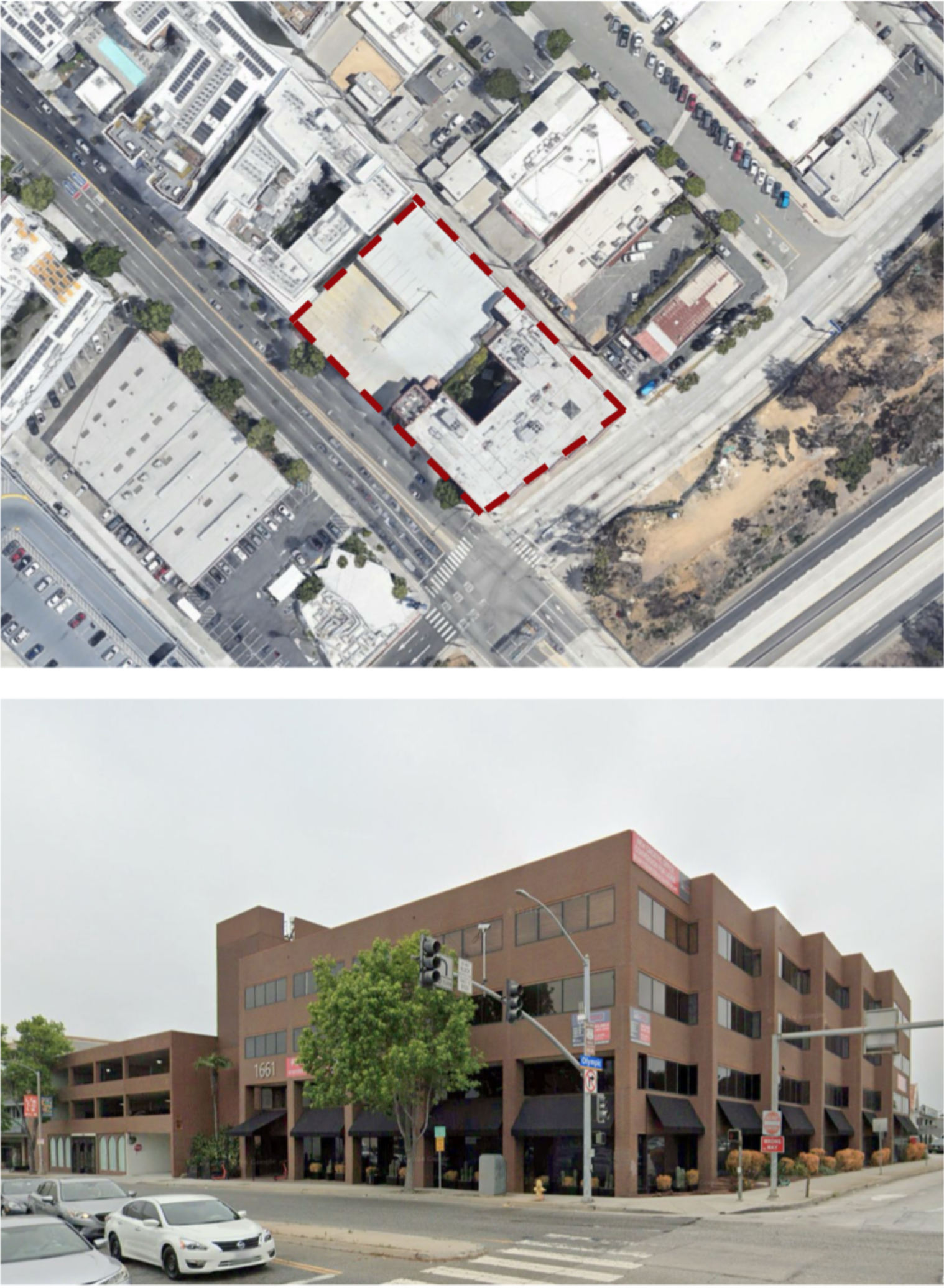
Agency / Organization:
City of Santa Monica, Planning Department
Status:
Complete
Intent:
California’s Department of Housing and Community Development implements a Regional Needs Housing Allocation (RHNA) that requires local jurisdictions to plan for housing needs in each region of the state. The City of Santa Monica was quick to recognize the importance of reusing their existing buildings and providing incentives for Developers to convert underutilized buildings into housing, and also create new construction housing as a part of this incentive without drastically altering the density and quality of their City.
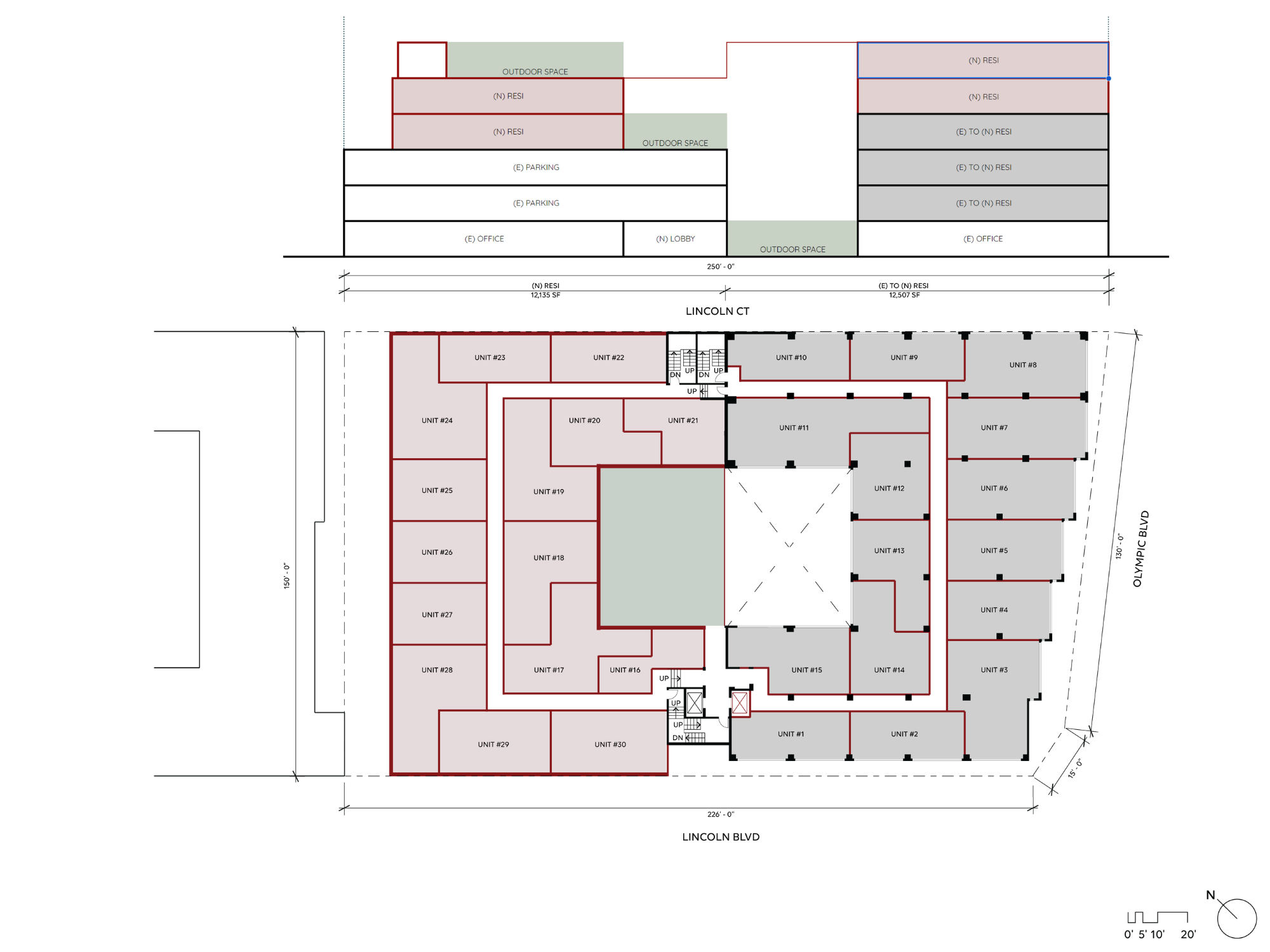
Omgivning was asked to take the City’s new planning policies for the adaptive reuse and redevelopment of properties for housing and apply them to five different building types. The process allowed for the Planning Department to see the actual impact of the policy and help them modify and craft the incentives properly. Modeling incentives on actual buildings and sites is imperative for Planners to see the effects of the policies they implement. As an Architect that works closely with Developers from the vision and financial aspects of a project, in addition to doing our own Developments, we are most adept at seeing all sides of planning policy and can help make adaptive reuse projects successful.
Read more about the the ARO incentives and Omgivning’s project models. https://omgivning.com/journal/omgivning-city-of-santa-monica-adaptive-reuse-ordinance/

Advocacy - City of San Jose - Saving Old City Hall
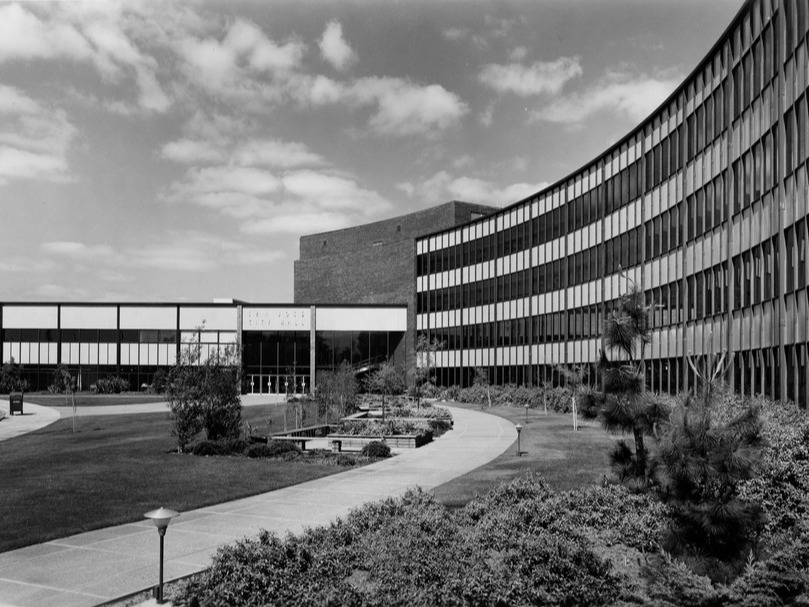
Agency / Organization:
Preservation Action Council of San Jose (PAC*SJ)
Status:
Complete / In progress
Intent:
The Preservation Action Council of San Jose (PAC*SJ) and its dedicated partners and allies celebrated a significant advocacy achievement in 2022 with their successful campaign to
prevent the demolition of San Jose’s former City Hall. Celebrated as a modern marvel when it opened in 1958, the five-story, 113,000-square-foot structure was one of the first International Style civic buildings constructed on the West Coast and a groundbreaking example of glass
curtain wall construction, designed by locally prominent architect Donald Francis Haines. It survives today as an iconic symbol of the city's 20th-century suburban expansion and proud
legacy of progressive civic participation, eligible for listing in the National Register of Historic Places for its architectural and cultural significance.
Unfortunately, Former City Hall has been vacant since 2005, when a new downtown City Hall was completed. In 2011, ownership transferred to Santa Clara County, which has maintained
but never occupied the structure. In early 2020, County staff announced their intention to demolish the building, citing ongoing maintenance and security costs.

From the outset of its campaign, PACSJ identified two major obstacles to a successful preservation outcome. First, like many buildings of its era and style, Former City Hall suffered
from a relative lack of public appreciation or widespread recognition of its historic significance,especially among County staff, whose current offices stand immediately adjacent to the long-vacant building. Second, the County had commissioned an initial study that accompanied the demolition proposal, concluding (incorrectly, in PACSJ and Omgivning’s opinion) that reuse of the building would be prohibitively expensive and structurally infeasible.
Recognizing the existential threat that both challenges posed, PAC*SJ undertook a two-pronged advocacy strategy to both “rehabilitate” the building’s stature in the mind of the public and its elected officials, and to simultaneously develop a compelling reuse strategy that convincingly challenged the assumptions and conclusions of the County’s initial study.
To achieve the first goal—heightened public awareness and appreciation—PACSJ featured the building prominently in its inaugural “Endangered Eight” list of threatened historic resources and developed a website featuring archival images highlighting the building’s architectural and historic significance. As the civic heart of San Jose during an era of profound physical and cultural transformation, PACSJ emphasized the building’s strong associations with two groundbreaking mayors—Norman Mineta, the first Asian-American mayor to lead a major U.S. city, and Janet Gray Hayes, the first female mayor of a major U.S. city. This campaign culminated in a targeted letter-writing campaign and a public petition directed to the County Board of Supervisors. PAC*SJ collaborated with local neighborhood organizations and Docomomo NOCA promoted the petition through social media and in-person events, resulting in over 300 citizens signing onto the following statement:
I support the preservation and adaptive reuse of San Jose's historic 1958 City Hall, a civic icon and architectural landmark with immense potential for adaptive reuse. Demolishing this building for a vacant lot would be an environmental, fiscal, and cultural mistake and a lost opportunity for responsible and transformative redevelopment.
To address the second major challenge—the County’s “infeasibility analysis”—PAC*SJ commissioned an independent peer review and alternative redevelopment proposal from a highly-respected team of subject-matter experts led by Omgivning, who immediately recognized the potential for Former City Hall to be a compelling demonstration project. Our deep understanding of adaptive reuse and years of experience in historic conversions were further augmented by a select team of expert consultants Omgivning recruited for the project. These included Swinerton Builders, who analyzed the County’s rehabilitation figures and flagged major unsupported assumptions and unrealistic assessments; Architectural Resources Group, who helped ensure that the proposed reuse plan would meet historic design standards; and Degenkolb Engineers, who developed a cost-effective seismic retrofit strategy for the building. Degenkolb’s involvement was particularly significant, as this 83-year-old firm also engineered the building’s original design in 1958!

PAC*SJ’s two-pronged “hearts and minds” advocacy strategy culminated in a crucial Board of Supervisors vote on November 15, 2022. Armed with the public petition, the alternative redevelopment proposal, and a favorable recommendation against demolition from the Santa Clara County Historical Heritage Commission, an advisory body whose appointed members were also vocal advocates for the building’s preservation, the Supervisors ultimately voted 4-0-1 to reject the proposed demolition plan and redirected County staff to more thoroughly explore reuse options for the Former City Hall!
The team has been awarded the Docomomo Modernism in America Award in 2023 and the California Preservation Foundation President's Award for Advocacy in 2024. Recognition of this ongoing advocacy campaign by these organizations is a powerful and persuasive validation that Former City Hall stands today as so much more than a vacant, disposable building. Instead, it represents a nationally significant opportunity to highlight the cultural, environmental, and economic benefits of preservation, honoring the past while embracing new possibilities and meeting new challenges.
In Progress: While this watershed vote was an affirmation that adaptive reuse—not demolition—should be the preferred path forward, PAC*SJ’s advocacy work remains far from complete. The building no longer faces the imminent threat of demolition, but County staff have yet to outline a path forward, and the building remains vacant and vulnerable to time, the elements, and the uncertain support of future County Supervisors.
Along with PAC*SJ and its partners and allies, we must continue to press elected officials and the local development community, which is often ambivalent towards or even hostile to preservation solutions, to embrace the adaptive reuse potential of this landmark modern building.
https://www.docomomo-us.org/register/former-san-jose-city-hall
The full study PDF: https://drive.google.com/file/d/127y-Ymma7Ck8VMXhMMftCgAbql1V3z_V/view?usp=drive_link
Advocacy - CCA White Paper - Adaptive Reuse Reimagining Our City’s Buildings to Address Our Housing, Economic and Climate Crises
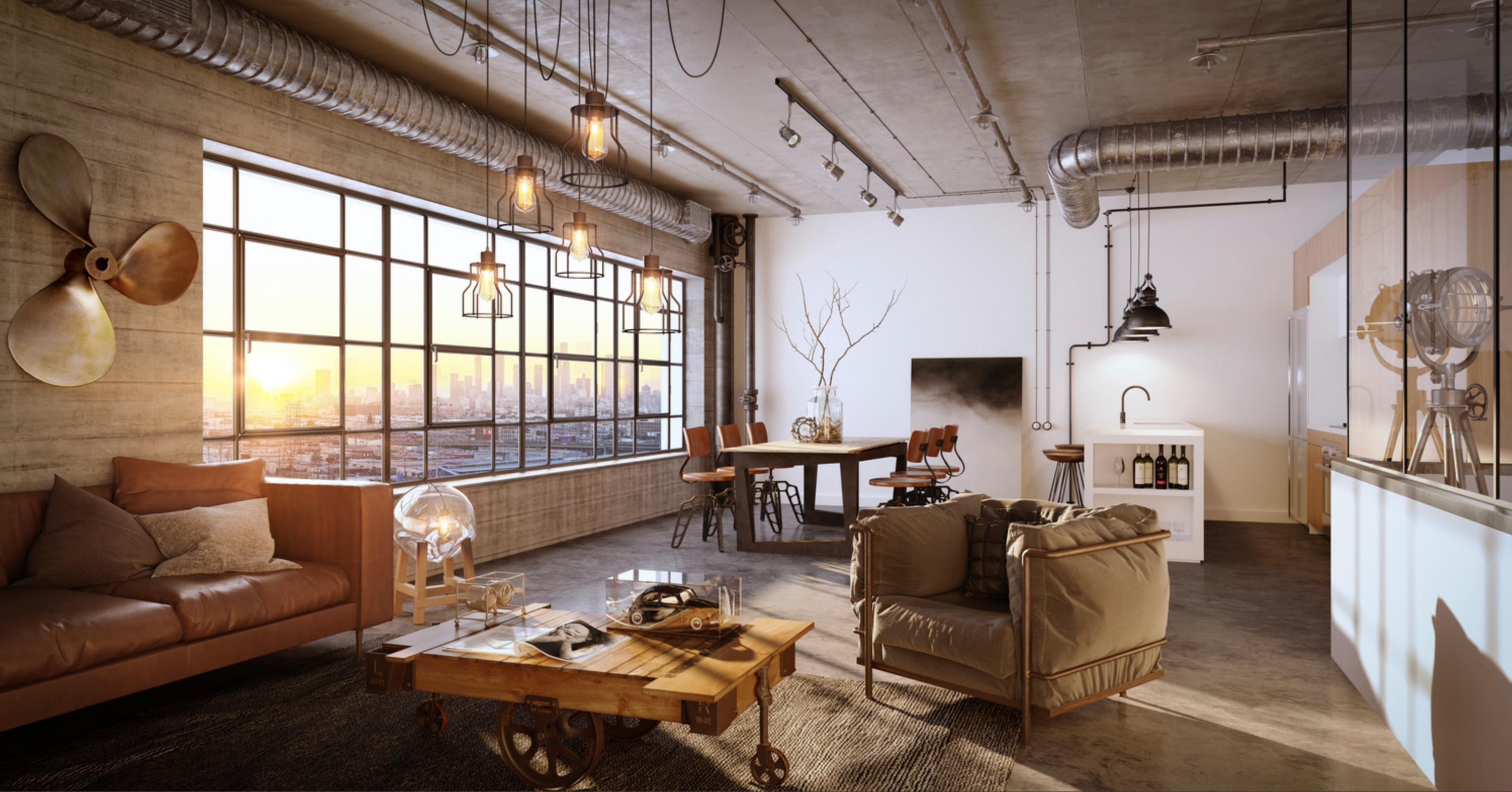
Agency / Organization:
Central City Association of Los Angeles (CCA)
Status:
Complete
Intent:
Omgivning partnered with the Central City Association of Los Angeles (CCA) to co-author a white paper, issued in 2021, that highlights the benefits of adaptive reuse to address economic recording,and provides concrete steps the City of Los Angeles can take to allow for new uses in existing structures.
The Covid-19 pandemic, housing shortage and climate change continue to impact cities, and one of best and most powerful tools to tackle these issues is adaptive reuse: reimagining and repurposing existing older structures and spaces to meet today’s needs.
Adaptive reuse has a wide range of benefits for cities, including: Supporting recovery from COVID-19 by converting vacant and/or underutilized spaces to be active uses that better contribute to the health of neighborhoods, which fosters jobs and tax revenues and can create new opportunities for housing and meet other community needs. Proactively preserving both historic and background structures through reinvestment and generating revenues by changing in alignment with real estate trends. Improving environmental sustainability by updating older, less energy efficient buildings to contemporary standards and promoting walkable, mixed-use neighborhoods through infill development and making use of already in place and often under-used (in terms of capacity) urban infrastructure.
CCA references this white paper as the foundation for the framework on which they have been strongly advocating for policy reform both at the local city level and at the state level.
